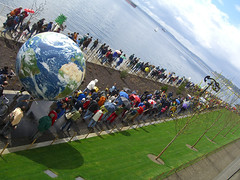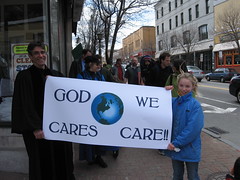As part of my inquiry, I interviewed someone who has worked in the environmental sector for twenty years, including some work specifically with the religious environmental community. One of her areas of expertise is coalition-building, especially among religious and environmental organizations. As I did not ask permission to publicly use her name in this blog, I am just going to call her Jane (not her real name). We had a lovely talk, and if this research turns into a thesis like I think it might, I hope to interview her again.
Part of the interview was Jane recommending authors, organizations, and people working in the religious environmental arena that she thought would be good resources for me. Many of her suggestions have made it into my list of “Resources” to the right. A good part of the interview was a rambling conversation about the topics of environment, spirituality, and the environmental movement. Below are some of her insights and some highlights of the directions our conversation took.

Early on, Jane stated, “The environmental crisis is a spiritual crisis. It is a movement away from oneness, connection.” I began this quarter writing in my syllabus, “It is my belief that this sense of human disconnection from nature is at the root of our current environmental crisis,” so Jane and I were in agreement from the start.
Without separation, she explained to me, we don’t have the experience of coming back together, of union. That longing for union is a driving need. Our separation, and not just from nature, leaves us with a longing to be filled. This longing has found many different outlets in modern society – for example, our materialism, in a world where many don’t have adequate access to the basic materials needed for life. This observation let Jane to say that it was the loss of balance, more so than loss of connection, which is the real crisis. Balance in nature is dynamic and changing and often cyclical, and that is true also in terms of the type of balance we need. It’s not about going back to the Stone Age – it’s about coming back to right relationship here and now.
People want and seek a direct relationship with nature. And yet, we also want to keep their spirituality compartmentalized – something above it all. Yes, those times of that spiritual connection are important. Yet, Jane argued, we also need to reconnect our spiritual life with our “real” life. We have an incredible opportunity at this point in time to reconnect our spirituality and the environment, to reawaken our consciousness, to strive for balance and right relationship.
We spoke about the power of language. “God,” for example, means many things to many people. (Jane’s definition was that it is a symbolic term for whatever we want to be in relationship with. Personally, I like the word “Mystery” to describe what others might call God.) Additionally, religion, spirituality, mysticism, and activism – all are different, but have intersections, and the places where overlap occurs is powerful. Jane notes that Washington State has a large population of unaffiliated religious people – folks who identify as “spiritual but not religious.” (It also has a lot of outdoorsy people. Jane wondered if there was a connection between the two.)
People are attached to their language because it reflects their experience, and it ties them to community. If you can hear beyond the language, to let go of your own prejudices and assumptions, you will be able to find similarities, and be more able to hear what is really being said. As we explored the topic of connection between humans and nature, we acknowledged that our language and our world have shaped those topics into separate ideas even as we tried to describe them as one.

We also talked quite a bit about the environmental and religious environmental movements – and how they have been very separate from each other. The religious environmental movement came about at the same time, but separate from, the environmental movement – because the environmentalists wanted no part in the religious movement, and they generally have not been open to the spiritual aspects of environmental work. And yet, environmentalists use the same language to describe nature as mystics as other religious people do.
One essay Jane recommended to me was the influential Historical Roots of Our Ecological Crisis by Lynn White, Jr. in 1967, which pointed a finger at Christianity and the Biblical interpretation that humans have dominion over nature. This essay was a factor in environmentalists being wary of religious groups. Further, Jane believes environmentalists were concerned that the religious groups would be out to convert them.
Jane’s opinion was that environmentalists don’t want to connect with moderate religious people because it’s too close to home. 45% of moderate religious people voted for Bush because he talked about values. “Values,” she told me, is a term that means something (it is code for spiritual relationship) to some people, but this was missed by groups for which is meant something different. The progressive left pushed a whole bunch of people away – people who shared their values but came to it from a place of religion. This reflects a lack of recognition from an environmentalist standpoint about what moves people.
My talk with Jane felt like opening many doors. My list of books to read grows longer. The direction my inquiry could take expands. I would love to help bridge the gap between environmentalists and religious environmentalists, and certainly feel called or led to do that in my own spiritual communities. The growth of the religious environmental movement among major religious faiths in this country has the potential to lead to profound change. And yet I worry about some of my own hang-ups about language and my own prejudices – there are some religious beliefs that are in such opposition to my own, could I really be as open-minded as I’d like to be?
I also worry that pursuing how to bridge the gap between these two movements would lead me away from the piece that drives me, my interest in the experience of connection with nature, and the spiritual and holy aspects of that connection. Hmm ... or maybe that experience of connection with nature is actually the piece that would bring the two groups together?
(Originally posted on my Env & Spirit blog).
Very nice Laura--keep opening those doors. But don't forget those reflective pieces (like this blog post). In some ways they're your trail of bread crumbs so that you can better hold intention.
ReplyDeleteWow, Laura, what a conversation. You/"Jane" describe so well the divide that is often created between religious and environmentalist doctrine. I grew up in the "dominion over nature" family and am regarded as the truant environmentalist that has strayed from the flock. You got me thinking...is this a wedge or an opportunity? Hmmm...
ReplyDeleteI love learning from what you are doing Laura as I, on my own path, go forward in reclaiming my time with nature and connecting my spirit with it.
ReplyDeleteElise
Laura,
ReplyDeleteI found it pretty interesting that those "spiritual but not religious" people are mostly outdoorsy types. That describes me. I think that there is definitely a connection here for certain. I think that most "outdoorsy" types feel a connection with nature that others don't and not just for the aspect of play. Most of my outdoorsy friends do not care so much if they bag a peak or climb hard all day, they are purely enjoying being outside and in nature. I also think that you will find that your pursuit of bridging the gaps will most likely not deter you from what drives you. I can only imagine that it will bring you to an even deeper understanding of it. It is very important that everyone, no matter what their beliefs, are able to come together with nature and feel connected to it as we surely are. Love your post!
Laura
Laura Y - I don't actually know if the "spiritual but not religious" people are mostly outdoorsy types - what Jane told me is that both of those populations are high in the Pacific Northwest, and together we wondered if there was a connection, or if they were the same people. That is one example of the direction further research could take, but might take me away from what brought me to the topic in the first place.
ReplyDelete